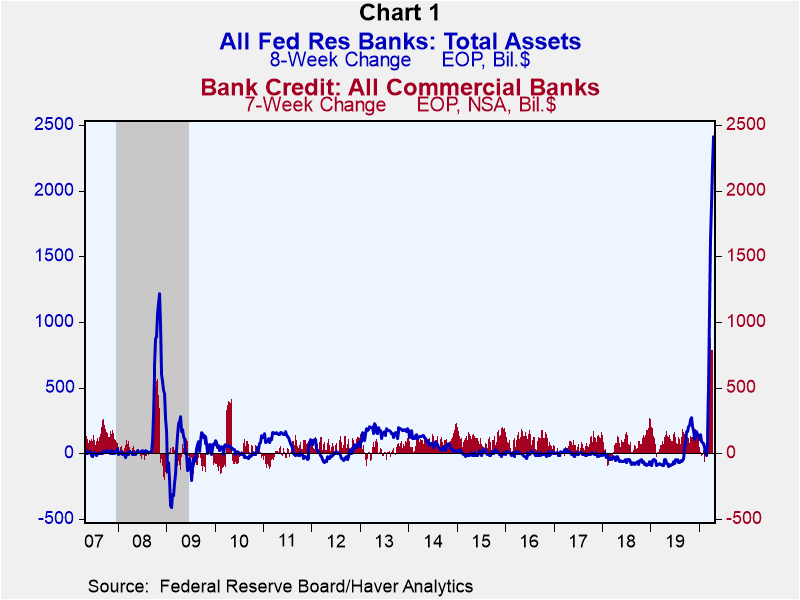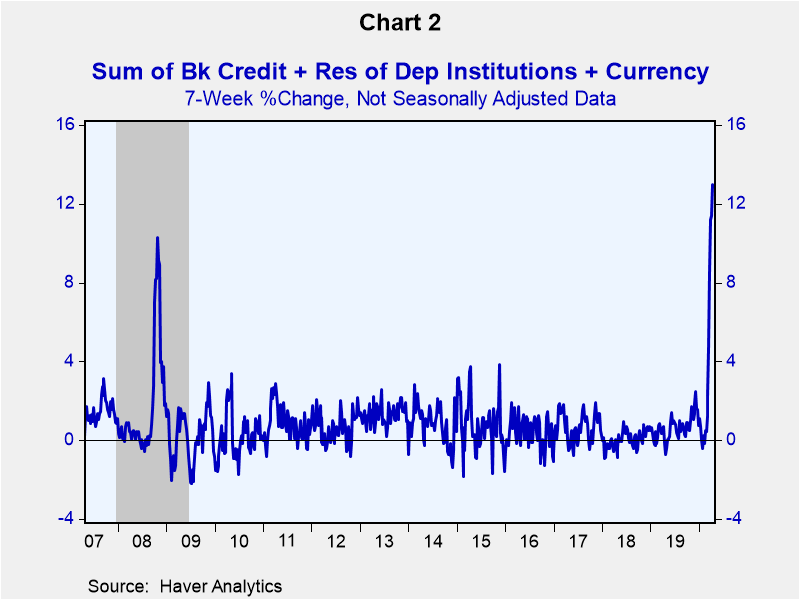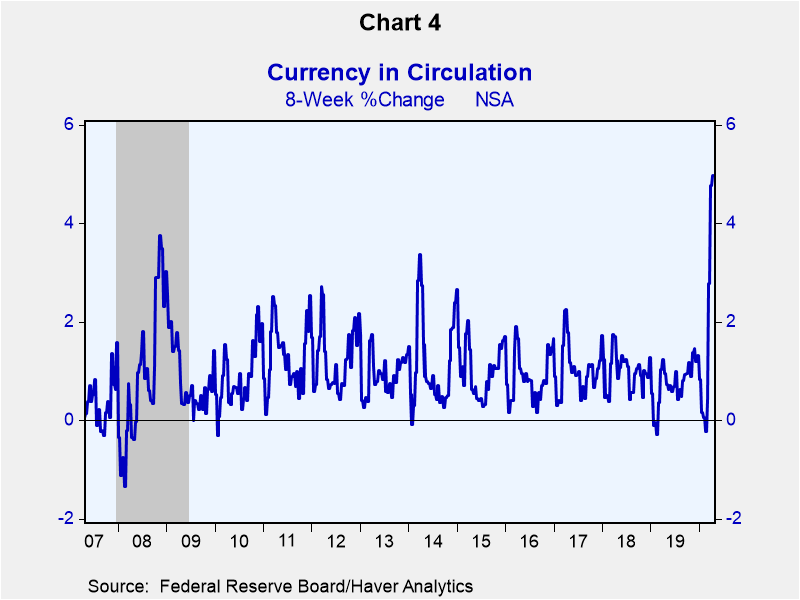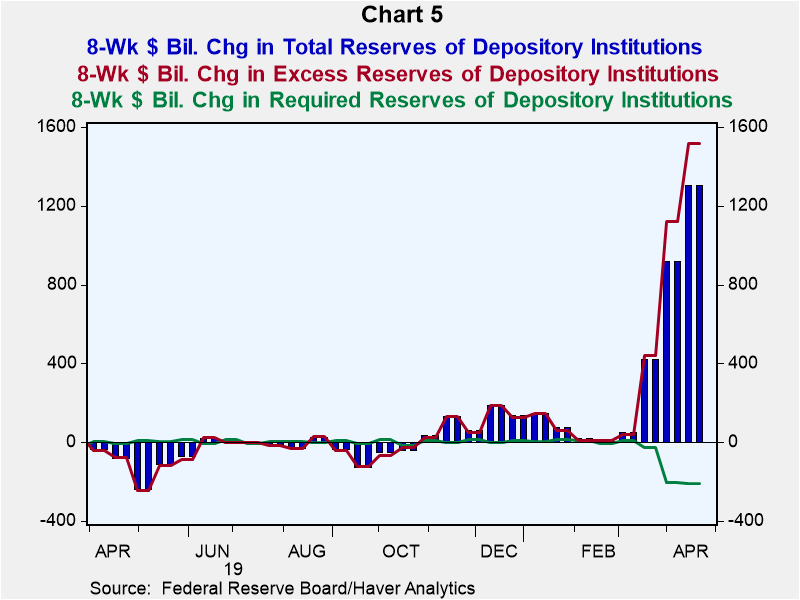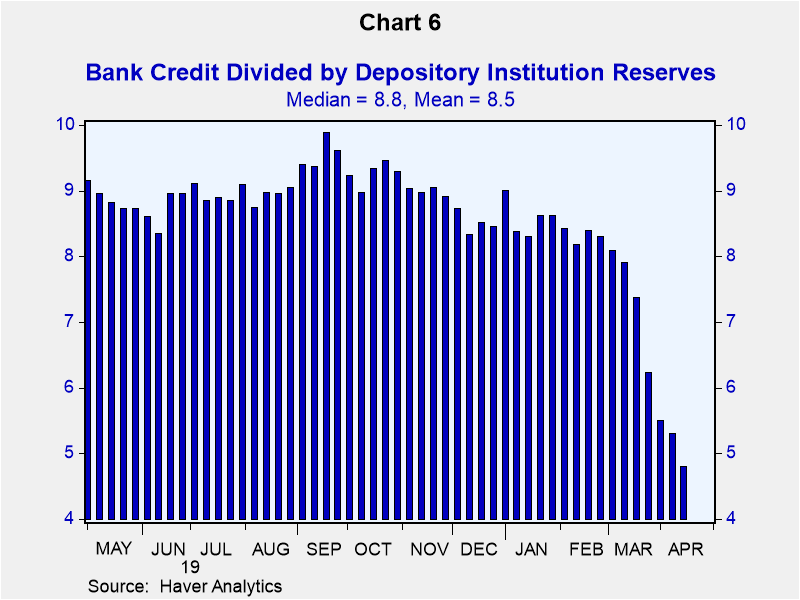 Global| Apr 30 2020
Global| Apr 30 2020The Explosion of the Fed's and Banks' Balance Sheets: Not Inflationary, Yet
Summary
In the eight weeks ended April 22, 2020, total assets on the books of the Fed increased by $2.4 trillion, the largest eight-week increase in Fed assets in the history of the institution. In the seven weeks ended April 15, 2020, loans [...]
In the eight weeks ended April 22, 2020, total assets on the books of the Fed increased by $2.4 trillion, the largest eight-week increase in Fed assets in the history of the institution. In the seven weeks ended April 15, 2020, loans and securities on the books of banks (bank credit), increased a whopping $780 billion. (See Chart 1). In the seven weeks ended April 15, 2020, the sum of bank credit, depository institution reserves created by the Fed and currency created by the Fed, a variation on what I call "thin-air" credit, increased by 13%, not annualized (see Chart 2). This seven-week growth in thin-air credit exceeds the fastest seven-week growth during the Great Recession of 10.3% in the seven weeks ended October 29, 2008. Is this explosion in thin-air credit inflationary?
Among my many errant forecasts, one of my worst was my prediction made back in late 2008 that inflation was going to pick up significantly because of the explosion in thin-air credit at that time. Fool me once? Milton Friedman allegedly said, facts don't speak for themselves; someone has to speak for them. So, let me speak for the fact that thin-air credit has recently surged. Plain and simple, the reason that depository reserves, currency and bank credit has increased by so much in recent weeks is that the Fed and banks have been accommodating a sharp increase in the demand for liquidity by just about every private entity. If this increased demand for liquidity had not been accommodated, the contraction in economic activity and the net decline in the value of risk assets would have been more severe.
Let's look at what category of bank credit has dominated the $780 billion increase in total bank credit in the seven weeks ended April 15. As shown in Chart 3, the increase in commercial and industrial (business) loans accounted for 64% of the seven-week increase in bank credit. Combined increases in banks' securities holdings, real estate loans (residential and commercial) and other loans, excluding consumer loans, accounted for 45% of the seven-week increase in bank credit. Consumer loans contracted by $63 billion in the seven-week period. It is doubtful that businesses increased their borrowing in the midst of coronavirus-induced shutdowns to expand their operations. Rather, it is more likely that they were tapping their pre-established credit lines for liquidity purposes as commercial paper and bond market financing became more difficult. Businesses also were borrowing to finance inventories and pay other operating expenses as revenues dried up. This increased bank borrowing is not inflationary. It is a temporary attempt to avoid bankruptcy.
In the eight weeks ended April 22, 2020, nonbank currency in circulation increased by $89 billion or by 5% not annualized (see Chart 4). This increased demand for currency exceeded the increased demand in 2008 when the financial system was melting down. In times of crisis, people want to hold more folding money. A small part of the increase in Fed assets was to accommodate this increased demand for currency.
In the eight weeks ended April 22, 2020, the Fed created $1.302 trillion of reserves for the depository institution (banking) system. Although an individual bank can rid itself of reserves, the banking system cannot (other than paying out currency to customers who redeem deposits for currency). Bank reserves can be categorized as either required reserves or excess reserves. Up until March 26, 2020, individual banks were required by the Fed to hold an amount of reserves equal to a certain percentage of certain categories of their deposits. As of March 26, the Fed cut the reserve-requirement percentage to zero. In the eight weeks ended April 22, the banking system's required reserves fell by $212 billion. Required reserves did not fall due to a fall in deposits, rather they fell because the Fed eliminated reserve requirements. The other category of reserves, excess reserves, is the amount of reserves banks hold in excess of their required reserves. So, total reserves equal required reserves plus excess reserves. It follows then that total reserves minus required reserves equal excess reserves. Given that in the eight weeks ended April 22, the Fed increased total reserves to the banking system by $1.302 trillion and required reserve fell by $0.212 trillion (or $212 billion), then excess reserves must have increased by $1.514 trillion. Chart 5 shows all of this.
I cannot prove that banks' demand for excess reserves increased in the wake of the partial cessation of economic activity across the U.S. and the world. Again, if the Fed increases the supply of reserves and required reserves decline because the Fed has reduced required reserves to zero, excess reserves must rise whether banks demand them or not. But during previous times of extreme financial uncertainty, when the reserve-requirement percentage was above zero, when the federal funds rate target was above zero, when the Fed did not pay interest on excess reserves, banks' demand for excess reserves did increase. Banks, similar to the rest of the private sector, want to increase their liquidity in the face of heightened uncertainty. So, it would be reasonable to assume that in recent weeks, banks' demand for reserves also increased.
One indirect way of gauging whether banks' demand for excess reserves have increased would be to look at banks' holdings of loans and securities in relation to total reserves. If banks' demand for reserves had not risen in the face of an increase in reserves, then, presumably, they would increase their loans and investments relative to the amount of reserves in the banking system. At the very least, that ratio would not decline. Alternatively, if banks' demand for reserves had increased, we would expect to see the ratio of aggregate bank credit to reserves in the banking system decline. I present Chart 6 in which this ratio is plotted over the past 12 months. As of April 15, the latest available data, this ratio stood at 4.8 versus its median value of 8.8 and its mean value of 8.5 over the period from the beginning of May 2019 through April 15, 2020. Thus, based on this indirect evidence, banks' demand for excess reserves has increased in recent weeks. If the Fed had not supplied extra reserves to accommodate banks' increased demand for them, the Fed would not have been able to keep the federal funds rate trading near the lower level of its March 15 targeted band of 0.00 to 0.25% and bank credit would not have increased as much as it did.
In sum, the extraordinary increase in Fed and bank credit in recent weeks does not appear to me to be inflationary in the current environment. Rather, this increase seems to be an accommodation to private entities' increased demand for liquidity in these times of increased uncertainty and the drying up of available funds in the private debt markets. If the Fed and the banking system had not accommodated this increased demand for liquidity, the contraction in U.S. real economic activity would have been even more severe than it already has been.
The inflationary challenge for the Fed will come when the economy begins to recover from its virus-induced partial shutdown. The Fed would need to skillfully drain reserves from the banking system in order to prevent significantly higher inflation. But I think the Fed's anti-inflation challenge going forward will be all the more complicated by federal-debt management issues. Even before the pandemic, the U.S. was on a course of significant increases in budget deficits and federal debt due entitlement spending, defense spending and slower revenue growth due to recent tax-rate cuts. With the additional federal government spending in reaction to the pandemic, the U.S. Treasury will face its biggest debt-management challenge since the end of World War II. If the Fed is coerced into keeping interest rates artificially low so as to keep the cost of servicing the massive amount of federal debt that has been created in recent years and will be created in the coming years, I fear inflation will once again raise its ugly head. In addition, I believe the economic and political ramifications of the pandemic have dealt globalization a significant setback. There will be less offshoring and more onshoring. This will be akin to a negative productivity shock, implying that it will take more U.S. resources to produce a given amount of output. The Fed would need to be careful not to engineer stagflation under these circumstances. But a fuller discussion of these issues will have to wait until my next commentary.
Viewpoint commentaries are the opinions of the author and do not reflect the views of Haver Analytics.Paul L. Kasriel
AuthorMore in Author Profile »Mr. Kasriel is founder of Econtrarian, LLC, an economic-analysis consulting firm. Paul’s economic commentaries can be read on his blog, The Econtrarian. After 25 years of employment at The Northern Trust Company of Chicago, Paul retired from the chief economist position at the end of April 2012. Prior to joining The Northern Trust Company in August 1986, Paul was on the official staff of the Federal Reserve Bank of Chicago in the economic research department. Paul is a recipient of the annual Lawrence R. Klein award for the most accurate economic forecast over a four-year period among the approximately 50 participants in the Blue Chip Economic Indicators forecast survey. In January 2009, both The Wall Street Journal and Forbes cited Paul as one of the few economists who identified early on the formation of the housing bubble and the economic and financial market havoc that would ensue after the bubble inevitably burst. Under Paul’s leadership, The Northern Trust’s economic website was ranked in the top ten “most interesting” by The Wall Street Journal. Paul is the co-author of a book entitled Seven Indicators That Move Markets (McGraw-Hill, 2002). Paul resides on the beautiful peninsula of Door County, Wisconsin where he sails his salty 1967 Pearson Commander 26, sings in a community choir and struggles to learn how to play the bass guitar (actually the bass ukulele). Paul can be contacted by email at econtrarian@gmail.com or by telephone at 1-920-559-0375.


